Mechanical Properties and Microscopic Mechanism of a Multi-Cementitious System Comprising Cement, Fly Ash, and Steel Slag Powder
Abstract
:1. Introduction
2. Experimental Scheme
2.1. Materials
2.2. Preparation of Cement Paste Sample
2.3. Characterization and Testing
3. Analysis of Mechanical Results
3.1. Fluidity
3.2. Setting Time and Stability
3.3. Flexural and Compressive Strengths
4. Microscopic Mechanisms
4.1. Micromorphology
4.2. Quantitative Analysis of the Microstructure
4.3. Analysis of Micromechanisms and Mechanical Properties
5. Conclusions
- The remixing of SSP and FA could improve the fluidity of the cement paste, and the same amount of substitute cement under the synergistic effect of the two could extend the setting time of the cement paste. The amount of SSP exceeded 50%, resulting in an excessively long setting time of the sample and a lack of internal consolidation. This negatively impacts the mechanical properties and is not favorable for practical engineering applications. The Reynold’s test results showed that the stability of the cement paste slightly deteriorated when adding the SSP within a safe range.
- The beneficial effects of FA and SSP on the mechanical properties of the net cement paste was limited, and the early flexural and compressive strengths of the test groups containing SSP showed a decreasing trend with increasing admixture content. Nevertheless, when w/b was 0.4, the late strength of C60F20S20 was higher than that of C100F00S00. When the SSP content exceeded 20% or w/b increased, the mechanical properties of the paste were adversely affected.
- The SEM results showed that, compared with the control groups, the samples with the combined addition of SSP and FA exhibited a significant reduction in the number of needle-like AFt crystals with the increase in the aging period under the 28-day curing period. The samples cured for 28 d were significantly denser, which contributed to their internal density and compressive strength.
- Substituting an equivalent FA amount to replace 20% cement could increase the density and integrity of the sample microstructure, and the internal porosity of the paste improved with an increase in SSP when the fixed FA admixture was 20%. The sample strength decreased with increasing SSP, and compared with the difference in the components, the effect of the curing age on porosity reduction became more evident.
- Activation of SSP, mixing of SSP with other materials, and optimization of the mechanical properties of the FA–SSP–cement composite paste.
- The cementitious material proposed in this study was applied as the cementitious material for steel slag concrete, investigating the influence of the FA–SSP–cement composite paste on the strength and durability of the steel slag concrete.
- The long-term durability properties of composite pastes mixed with SSP and FA can be evaluated, e.g., erosion resistance, volumetric stability at longer ages (90, 180, and 365 days), permeation resistance, and frost resistance.
Author Contributions
Funding
Data Availability Statement
Conflicts of Interest
Nomenclature
| Growth rate of the compressive strength in the current aging period; | |
| Compressive strength at the current age, MPa; | |
| Compressive strength at the previous age, MPa; | |
| Roundness (mean); | |
| Perimeter of the sample, cm; | |
| Pore area. |
References
- Han, F.; Zhang, Z.; Wang, D.; Yan, P. Hydration heat evolution and kinetics of blended cement containing steel slag at different temperatures. Thermochem. Acta 2015, 605, 43–51. [Google Scholar] [CrossRef]
- Shi, C. Steel Slag—Its Production, Processing, Characteristics, and Cementitious Properties. Cheminform 2005, 36, 230–236. [Google Scholar] [CrossRef]
- Jianlong, G.; Yanping, B.; Min, W. Steel slag in China: Treatment, recycling, and management. Waste Manag. 2018, 78, 318–330. [Google Scholar] [CrossRef]
- Dhoble, Y.N.; Ahmed, S. Review on the innovative uses of steel slag for waste minimization. J. Mater. Cycles Waste Manag. 2018, 20, 1373–1382. [Google Scholar] [CrossRef]
- Gencel, O.; Karadag, O.; Oren, O.H.; Bilir, T. Steel slag and its applications in cement and concrete technology: A review. Constr. Build. Mater. 2021, 283, 122783. [Google Scholar] [CrossRef]
- Sheen, Y.N.; Wang, H.Y.; Sun, T.H. A study of engineering properties of cement mortar with stainless steel oxidizing slag and reducing slag resource materials. Constr. Build. Mater. 2013, 40, 239–245. [Google Scholar] [CrossRef]
- Akinwumi, I. Soil Modification by the Application of Steel Slag (periodica polytechnica ci Creative Commons Attribution). Period. Polytech. Civ. Eng. 2014, 58, 371–377. [Google Scholar] [CrossRef]
- Kuznetsov, D.; Vysotskaya, M.; Burgonutdinov, A. Using Steel–Smelting Slag as a Raw Material Component in the Production of Asphalt Concrete. E3S Web Conf. 2020, 157, 06010. [Google Scholar] [CrossRef]
- Jiang, Y.; Ling, T.C.; Shi, C.; Pan, S.Y. Characteristics of steel slags and their use in cement and concrete—A review. Resour. Conserv. Recycl. 2018, 136, 187–197. [Google Scholar] [CrossRef]
- Wang, S.; Long, Y.; Zhang, Y.; Xing, H.; Hu, C.; Li, J. Comparison and analysis of steel slag treatment method and comprehensive utilization. Steelmaking. 2010, 26, 75–78. [Google Scholar]
- Dong, T.; Tao, Z.D.; Qing, C. Study on using steel slag as a raw meal component for cement clinker. In Proceedings of the International Conference on Materials for Renewable Energy and Environment, Shanghai, China, 20–22 May 2011. [Google Scholar] [CrossRef]
- Shi, Y.; Chen, H.Y.; Wang, J. Effects of Ultrafine Grinded Steel Slag Addition on Properties of Cement. Mater. Sci. Forum 2014, 804, 67–70. [Google Scholar] [CrossRef]
- Wang, Q.; Yan, P.; Mi, G. Effect of blended steel slag–GBFS mineral admixture on hydration and strength of cement. Constr. Build. Mater. 2012, 35, 8–14. [Google Scholar] [CrossRef]
- Wang, Q.; Yan, P. Early hydration characteristics and paste structure of complex binding material containing high–volume steel slag. J. Chin. Ceram. Soc. 2008, 36, 1406–1411. [Google Scholar] [CrossRef]
- Liu, Y.; Zhang, Z.; Hou, G.; Yan, P. Preparation of sustainable and green cement–based composite binders with high–volume steel slag powder and ultrafine blast furnace slag powder. J. Clean. Prod. 2020, 289, 125133. [Google Scholar] [CrossRef]
- Kourounis, S.; Tsivilis, S.; Tsakiridis, P.E.; Papadimitriou, G.D.; Tsibouki, Z. Properties and hydration of blended cements with steelmaking slag. Cem. Concr. Res. 2007, 37, 815–822. [Google Scholar] [CrossRef]
- Shi, H. Utilization of Steel Slag Powder as a Combined Admixture with Ground Granulated Blast–Furnace Slag in Cement Based Materials. J. Mater. Civ. Eng. 2013, 25, 1990–1993. [Google Scholar] [CrossRef]
- Zhao, J.; Li, Z.; Wang, D.; Yan, P.; Luo, L.; Zhang, H.; Zhang, H.; Gu, X. Hydration superposition effect and mechanism of steel slag powder and granulated blast furnace slag powder. Constr. Build. Mater. 2023, 366, 130101. [Google Scholar] [CrossRef]
- Mengxiao, S.; Qiang, W.; Zhikai, Z. Comparison of the properties between high–volume fly ash concrete and high–volume steel slag concrete under temperature matching curing condition. Constr. Build. Mater. 2015, 98, 649–655. [Google Scholar] [CrossRef]
- Ytterdal, S.G. The Effect of Fly Ash and GGBFS as Cement Replacement on Chloride Binding and Ingress in Mortar Samples. Master’s Thesis, Department of Civil & Transport Engineering, Norwegian University of Technology and Science (NTNU), Trondheim, Norway, 2014. [Google Scholar]
- Lee, C.Y.; Lee, H.K.; Lee, K.M. Strength and microstructural characteristics of chemically activated fly ash–cement systems. Cem. Concr. Res. 2003, 33, 425–431. [Google Scholar] [CrossRef]
- Zeng, Q.; Li, K.; Fen-chong, T.; Dangla, P. Determination of cement hydration and pozzolanic reaction extents for fly-ash cement pastes. Constr. Build. Mater. 2013, 27, 560–569. [Google Scholar] [CrossRef]
- Fang, M.; Fang, G.; Xia, Y.; Wang, H. Study on Compressive Strength of Concrete Mixed by Steel Slag Powder and Fly Ash. IOP Conf. Ser. Earth Environ. Sci. 2020, 508, 012183. [Google Scholar] [CrossRef]
- Ahmaruzzaman, M. A review on the utilization of fly ash. Prog. Energy Combust. Sci. 2010, 36, 327–363. [Google Scholar] [CrossRef]
- GB/T 20491–2017; Steel Slag Powder Used for Cement and Concrete. China Iron and Steel Association: Beijing, China, 2017.
- GB 175–2007; Common Portland Cement. China Building Material Council: Beijing, China, 2007.
- GB/T 1596–2017; Fly Ash Used for Cement and Concrete. China Building Material Council: Beijing, China, 2007.
- GB/T 1346–2011; Test Methods for Water Requirement of Normal Consistency, Setting Time and Soundness of the Portland Cement. China Building Material Council: Beijing, China, 2011.
- GB/T 8077–2012; Methods for Testing Uniformity of Concrete Admixture. China Building Material Council: Beijing, China, 2012.
- GB/T 17671–2021; Test Method of Cement Mortar Strength (ISO Method). China Building Material Council: Beijing, China, 2021.
- Liu, F.; Chen, M.Z.; Li, F.Z.; Li, Q.L.; Wu, S.P.; Sang, Y. Effect of ground steel slag powder on cement properties. Mater. Res. Innov. 2015, 19 (Suppl. S1), S1-150–S1-153. [Google Scholar] [CrossRef]
- Shuguang, H.; Yongjia, H.; Linnu, L.; Qingjun, D. Effect of fine steel slag powder on the early hydration process of Portland cement. J. Wuhan Univ. Technol. Mater. Sci. Ed. 2006, 21, 147–149. [Google Scholar] [CrossRef]
- Zhao, J.; Zhang, D.; Wang, D.; Lin, H. Cementitious Property of Steel Slag Powder and Impact on the Mechanical Property of Cement. In Proceedings of the 14th International Congress on the Chemistry of Cement ICCC 2015.0, Beijing, China, 13–16 October 2015. [Google Scholar]
- Kong, Y.; Wang, P.; Liu, S. Microwave pre–curing of Portland cement–steel slag powder composite for its hydration properties. Constr. Build. Mater. 2018, 189, 1093–1104. [Google Scholar] [CrossRef]
- Nwaubani, S.O.; Muntasser, T.Z. Hydration characteristics of cement pastes incorporating electric arc–furnace slag. Acad. J. 2012, 3, 291–300. [Google Scholar]
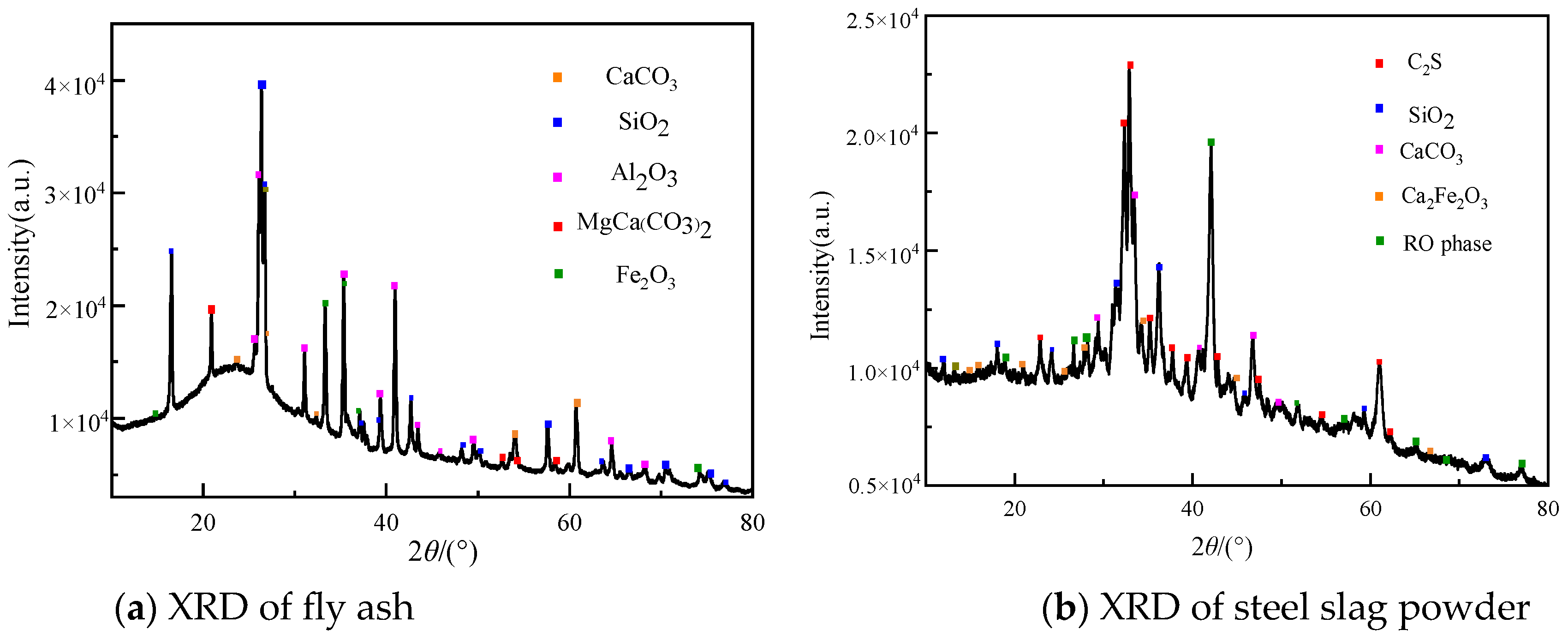


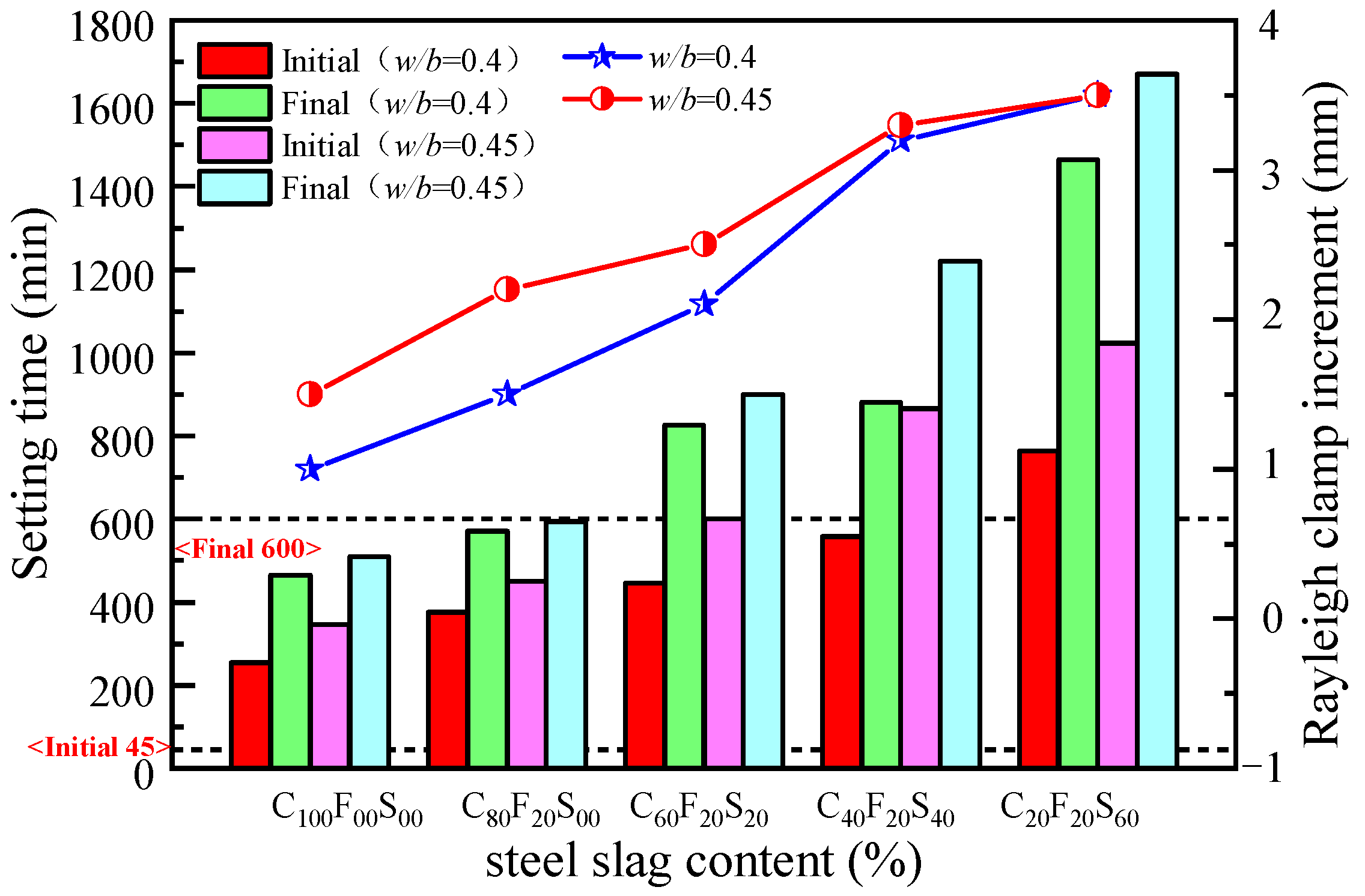
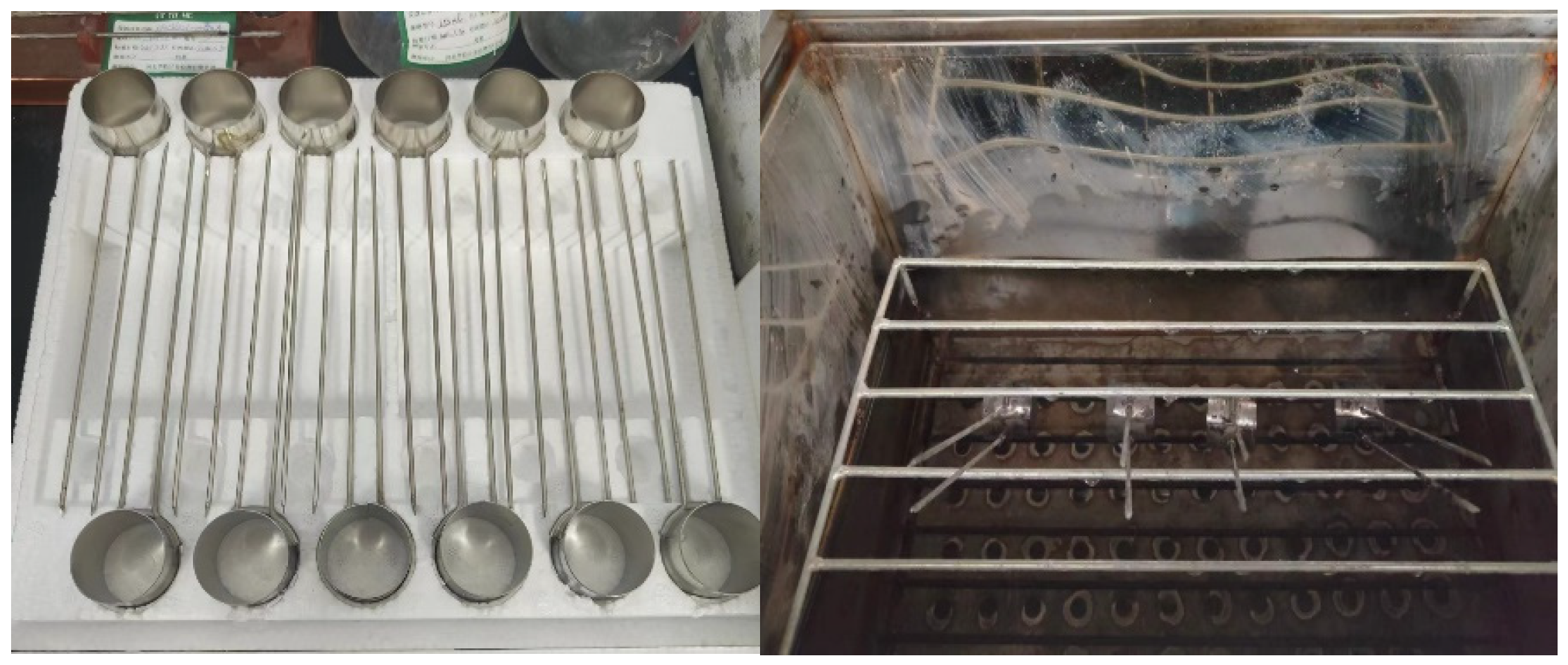

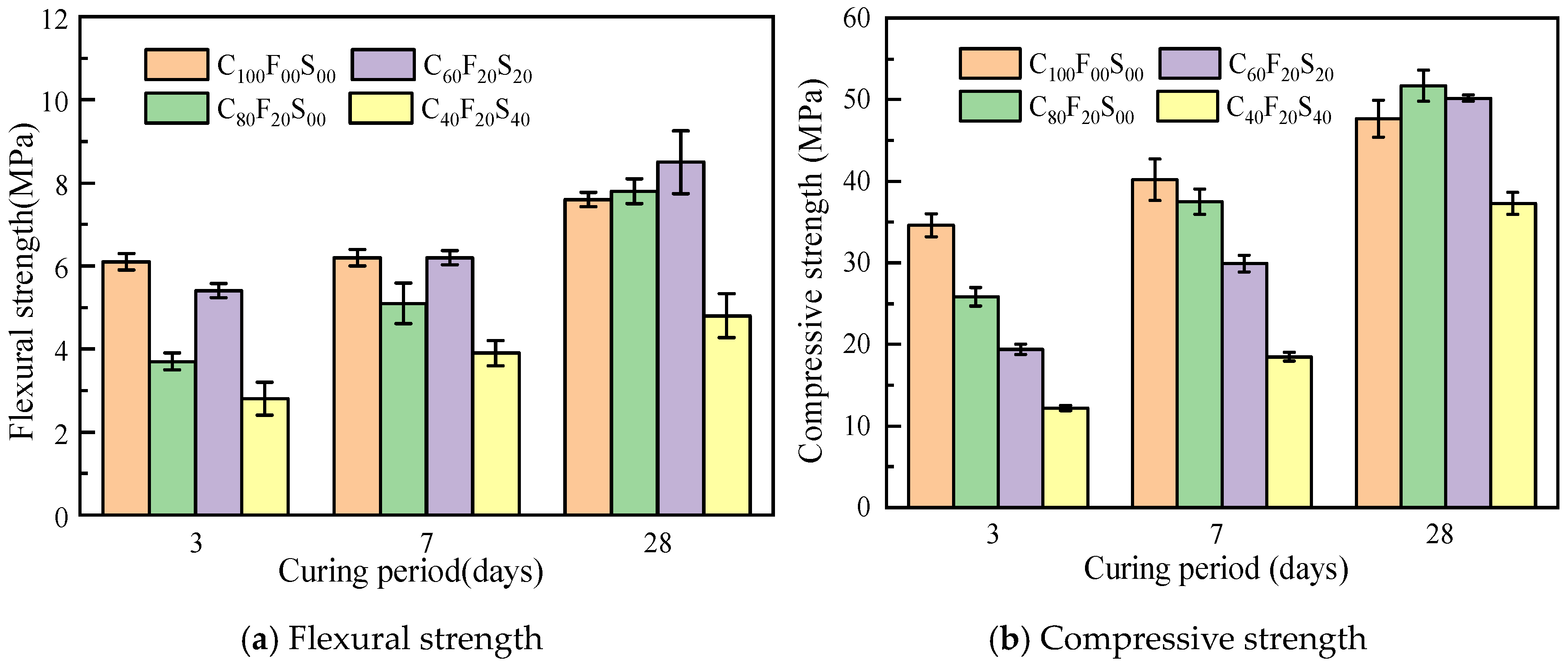

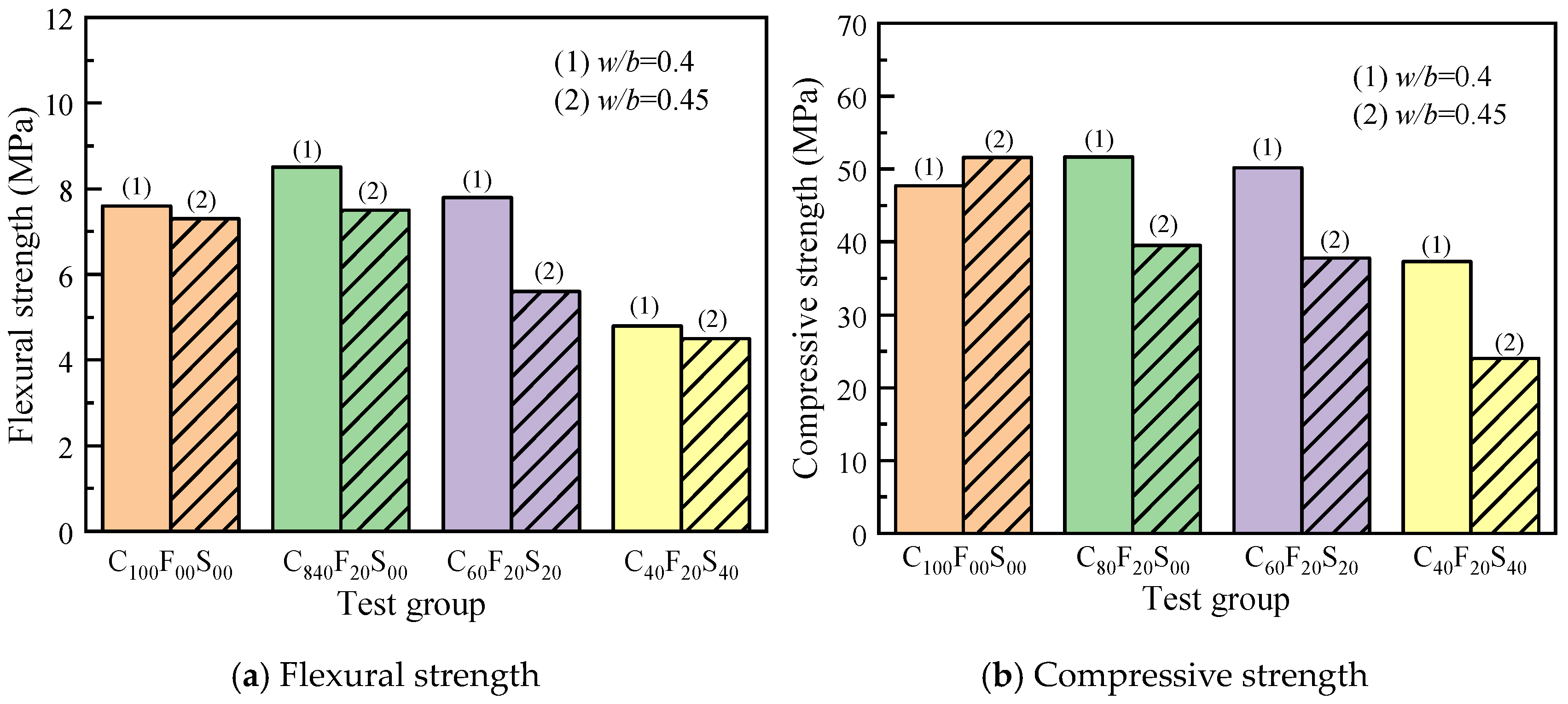
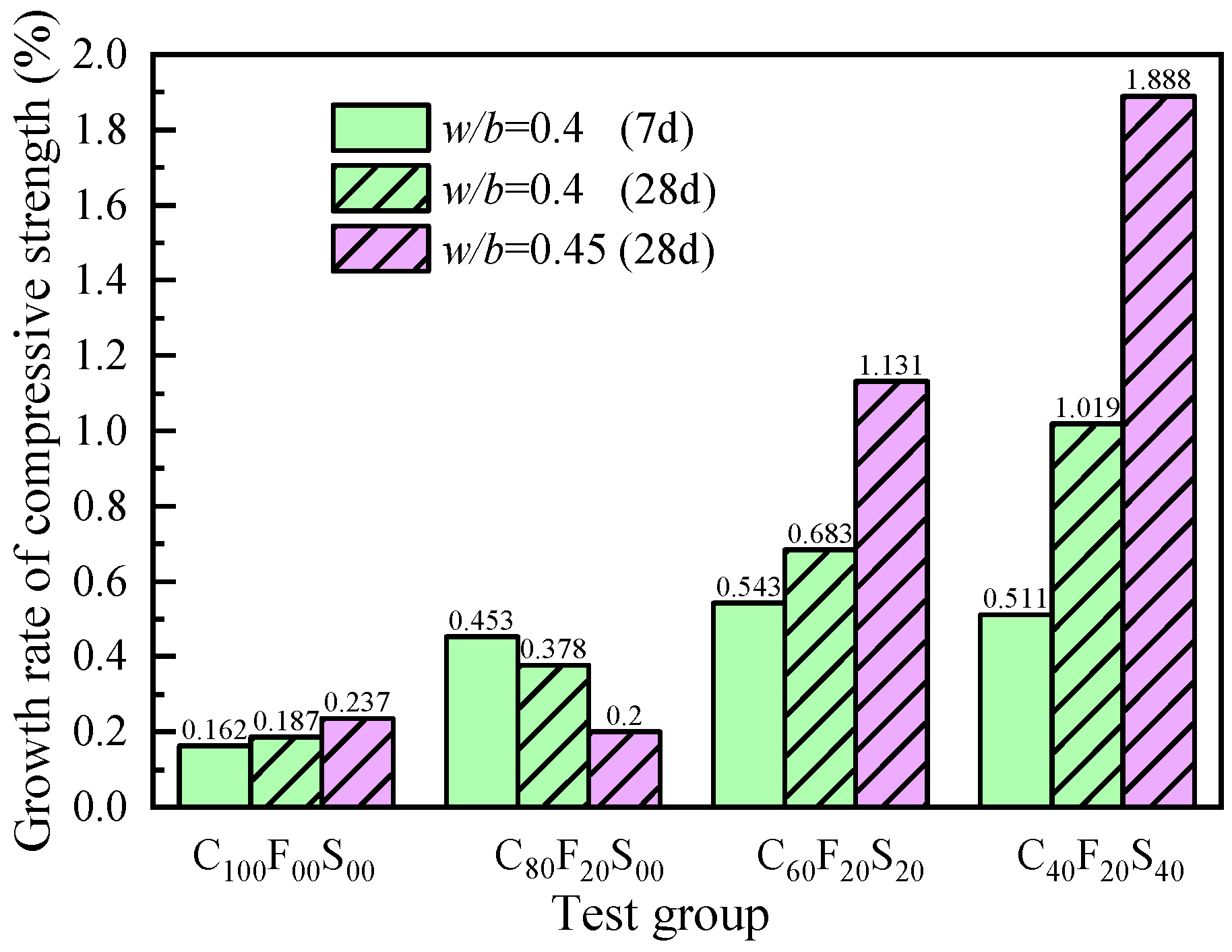

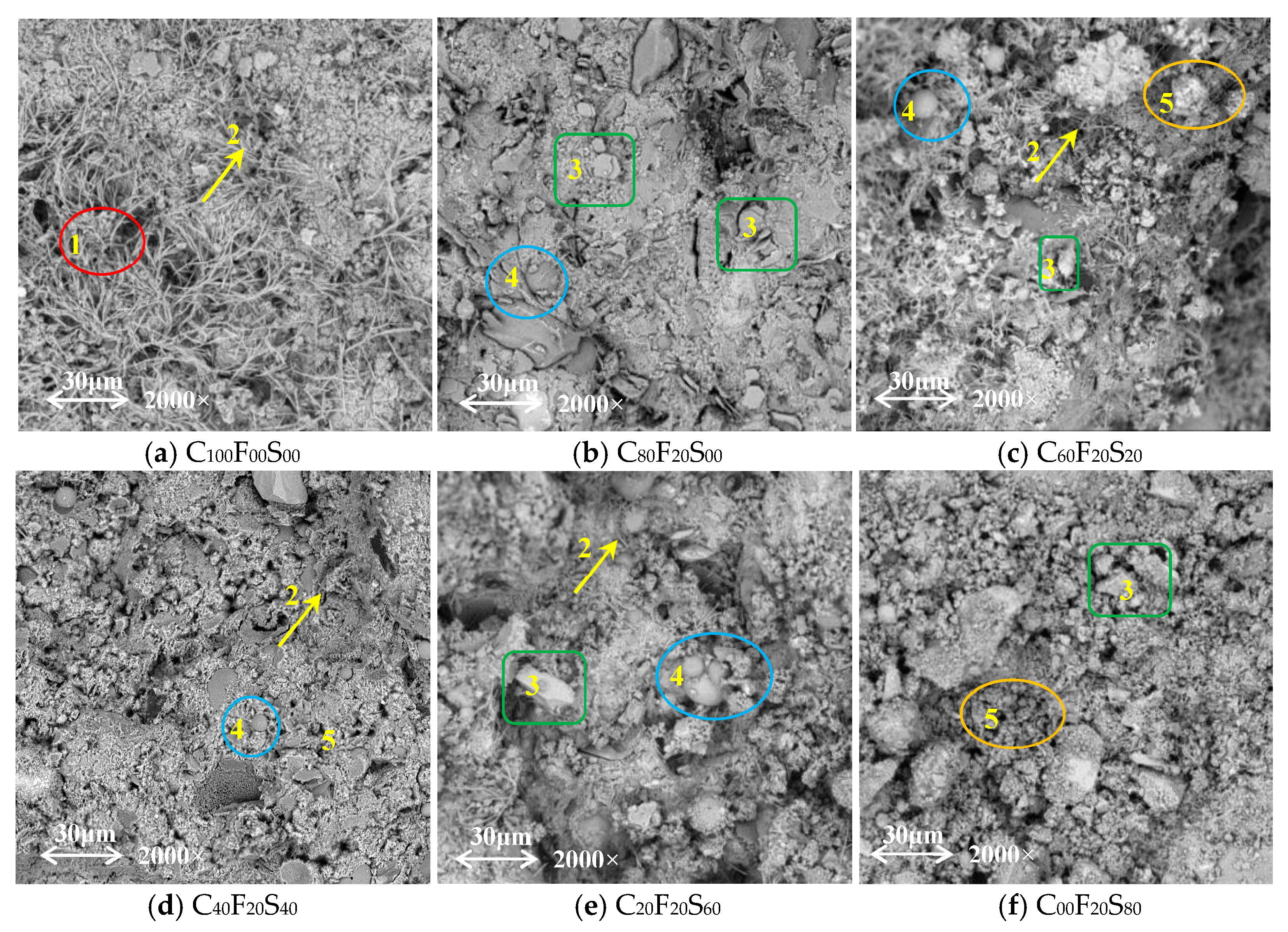
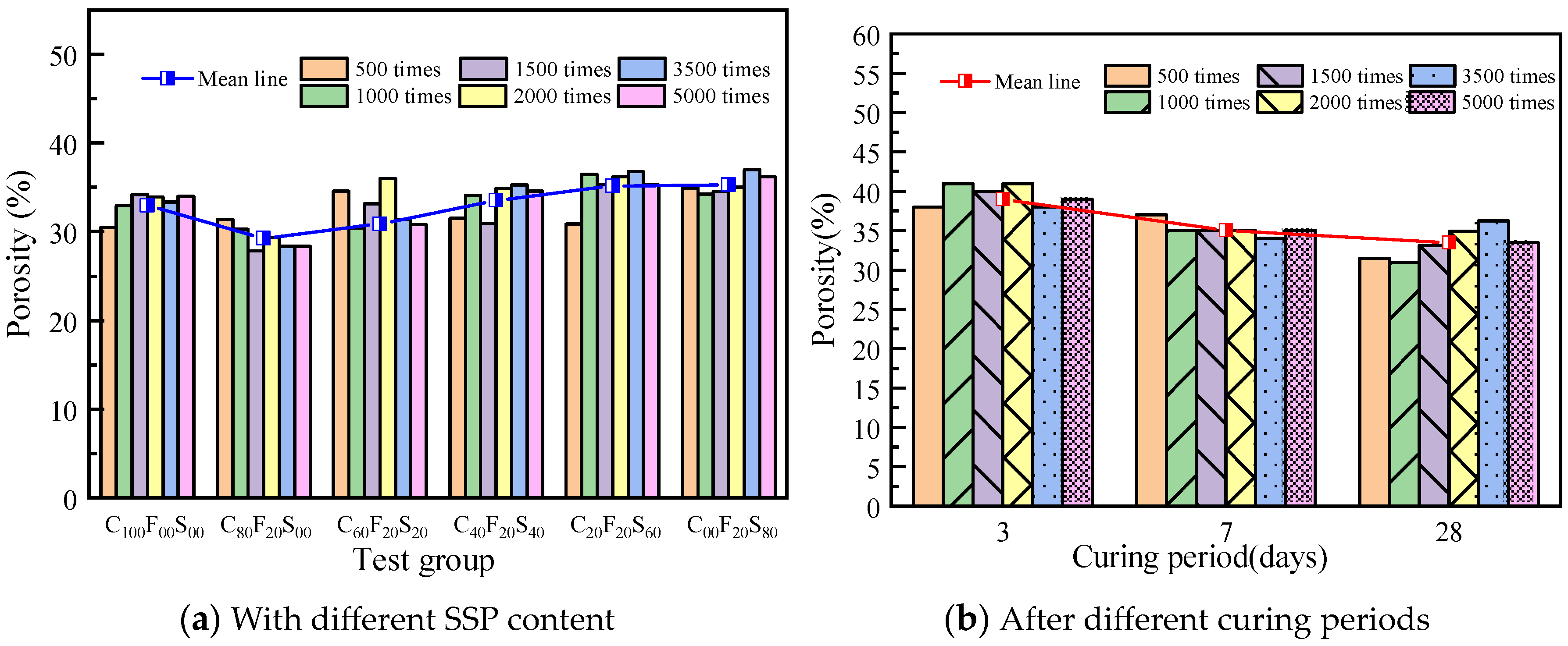

| Material | Density (g/m3) | Specific Area (m2/kg) | Water Content (%) | Loss on Ignition | Mobility Rate (%) | Activity Index (%) | Setting Time (min) | Stability (Reynold’s Method) |
|---|---|---|---|---|---|---|---|---|
| Cement | 3.1 | 380 | 0.02 | 4.0 | - | - | Initial = 194 Final = 315 | Qualified |
| FA | 2.1 | 350 | 0.9 | ≤6.5% | - | - | Qualified (≤4.5) | |
| SSP | 3.3 | 436 | 0.04 | 3.7 | 108 | 7 d = 70 28 d = 81 | - | Qualified |
| Material/wt.% | SiO2 | Al2O3 | Fe2O3 | CaO | MgO | SO3 | f-CaO | K2O | Cl– | MnO | Undissolved Substance | Total |
|---|---|---|---|---|---|---|---|---|---|---|---|---|
| FA | 40 | 30 | 4.2 | 10 | 2.5 | ≤2.5 | ≤0.95 | 1.1 | - | - | - | >97.8 |
| SSP | 19.48 | 6.25 | 21.18 | 32.7 | 6.01 | 0.25 | 2.41 | - | 0.02 | 1.90 | 7.3 | >97.5 |
| Group | Water-to-Binder Ratio (w/b) | Mass Fraction/% | Total (SSP + FA) | ||
|---|---|---|---|---|---|
| Cement | FA | SSP | |||
| C100F00S00 | 0.40 | 100 | 0 | 0 | 0 |
| C80F20S00 | 80 | 20 | 0 | 20 | |
| C60F20S20 | 60 | 20 | 20 | 40 | |
| C40F20S40 | 40 | 20 | 40 | 60 | |
| C20F20S60 | 20 | 20 | 60 | 80 | |
| C00F20S80 | 0 | 20 | 80 | 100 | |
| C00F00S100 | 0 | 00 | 100 | 100 | |
| C100F00S001 | 0.45 | 100 | 0 | 0 | 0 |
| C80F20S001 | 80 | 20 | 0 | 20 | |
| C60F20S201 | 60 | 20 | 20 | 40 | |
| C40F20S401 | 40 | 20 | 40 | 60 | |
| C20F20S601 | 20 | 20 | 60 | 80 | |
| C00F20S801 | 0 | 20 | 80 | 100 | |
| C00F00S1001 | 0 | 00 | 100 | 100 | |
| Water-to-Binder Ratio (w/b) | Flexural Strength (MPa) | Compressive Strength (MPa) | |||||
|---|---|---|---|---|---|---|---|
| 3 d | 7 d | 28 d | 3 d | 7 d | 28 d | ||
| 0.40 | C100F00S00 | 6.1 | 6.2 | 7.6 | 34.6 | 40.2 | 47.7 |
| C80F20S00 | 5.4 | 6.2 | 8.5 | 25.8 | 37.5 | 51.7 | |
| C60F20S20 | 3.7 | 5.1 | 7.8 | 19.4 | 29.9 | 50.2 | |
| C40F20S40 | 2.8 | 3.9 | 4.8 | 12.2 | 18.5 | 37.3 | |
| C20F20S60 | - | - | 3.5 | - | 5.4 | 8.3 | |
| 0.45 | C100F00S001 | 5.4 | 7.2 | 7.3 | 30.8 | 41.7 | 51.6 |
| C80F20S001 | 5.1 | 6.3 | 7.5 | 26.2 | 32.9 | 39.5 | |
| C60F20S201 | 2.8 | 3.9 | 5.6 | 9.8 | 17.8 | 37.8 | |
| C40F20S401 | 0 | 2.5 | 4.5 | 0.1 | 8.3 | 24 | |
| C20F20S601 | - | - | - | - | - | - | |
| C100F00S00 | C80F20S00 | C60F20S20 | C40F20S40 | C20F20S60 | ||
|---|---|---|---|---|---|---|
| Compressive strength (MPa) | 3 d | 34.6 | 25.8 | 19.4 | 12.2 | - |
| 7 d | 40.2 | 37.5 | 29.9 | 18.5 | 5.4 | |
| 28 d | 47.7 | 51.7 | 50.2 | 37.3 | 8.3 | |
| Porosity | 28 d | 0.359 | 0.292 | 0.309 | 0.335 | 0.351 |
Disclaimer/Publisher’s Note: The statements, opinions and data contained in all publications are solely those of the individual author(s) and contributor(s) and not of MDPI and/or the editor(s). MDPI and/or the editor(s) disclaim responsibility for any injury to people or property resulting from any ideas, methods, instructions or products referred to in the content. |
© 2023 by the authors. Licensee MDPI, Basel, Switzerland. This article is an open access article distributed under the terms and conditions of the Creative Commons Attribution (CC BY) license (https://creativecommons.org/licenses/by/4.0/).
Share and Cite
Zhang, Y.; Zhang, S.; Nie, Q.; Shen, L.; Wang, W. Mechanical Properties and Microscopic Mechanism of a Multi-Cementitious System Comprising Cement, Fly Ash, and Steel Slag Powder. Materials 2023, 16, 7195. https://doi.org/10.3390/ma16227195
Zhang Y, Zhang S, Nie Q, Shen L, Wang W. Mechanical Properties and Microscopic Mechanism of a Multi-Cementitious System Comprising Cement, Fly Ash, and Steel Slag Powder. Materials. 2023; 16(22):7195. https://doi.org/10.3390/ma16227195
Chicago/Turabian StyleZhang, Yuzhi, Shujing Zhang, Qingke Nie, Liang Shen, and Wei Wang. 2023. "Mechanical Properties and Microscopic Mechanism of a Multi-Cementitious System Comprising Cement, Fly Ash, and Steel Slag Powder" Materials 16, no. 22: 7195. https://doi.org/10.3390/ma16227195





